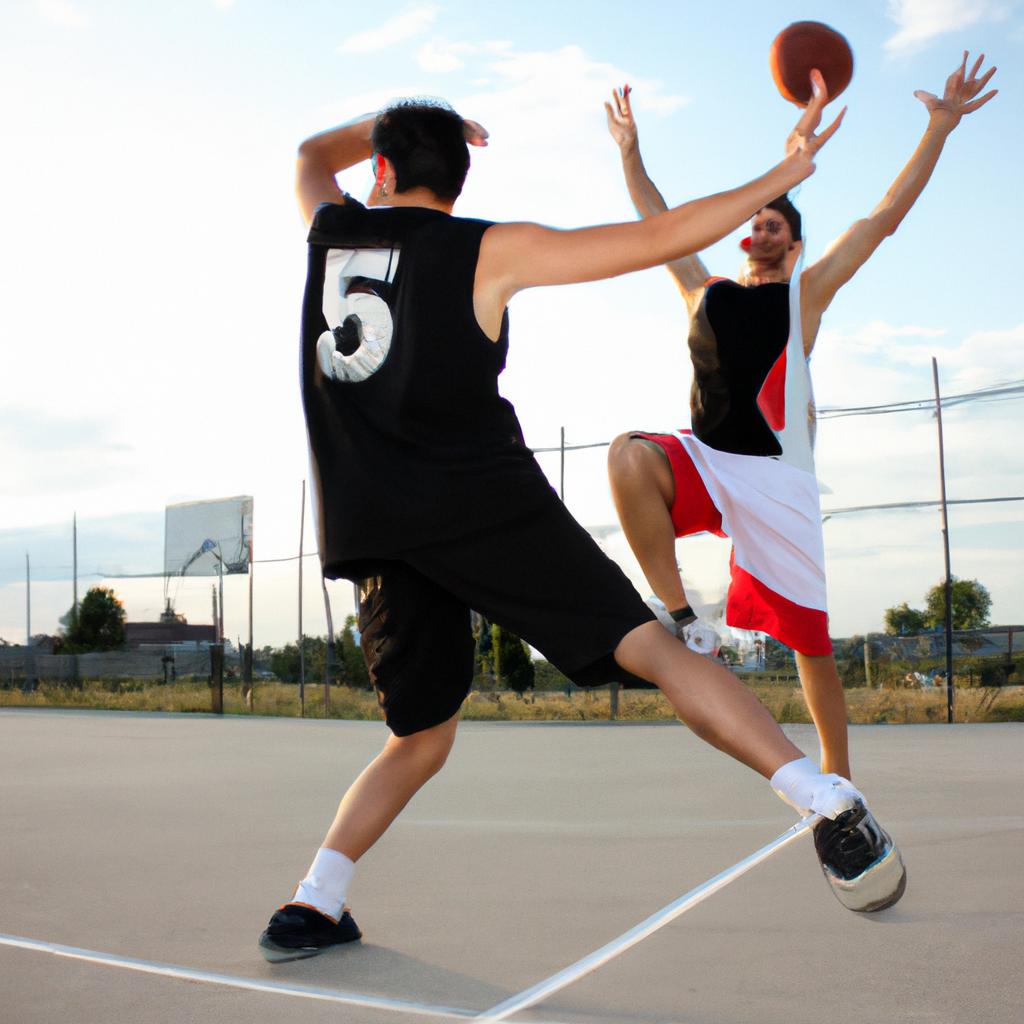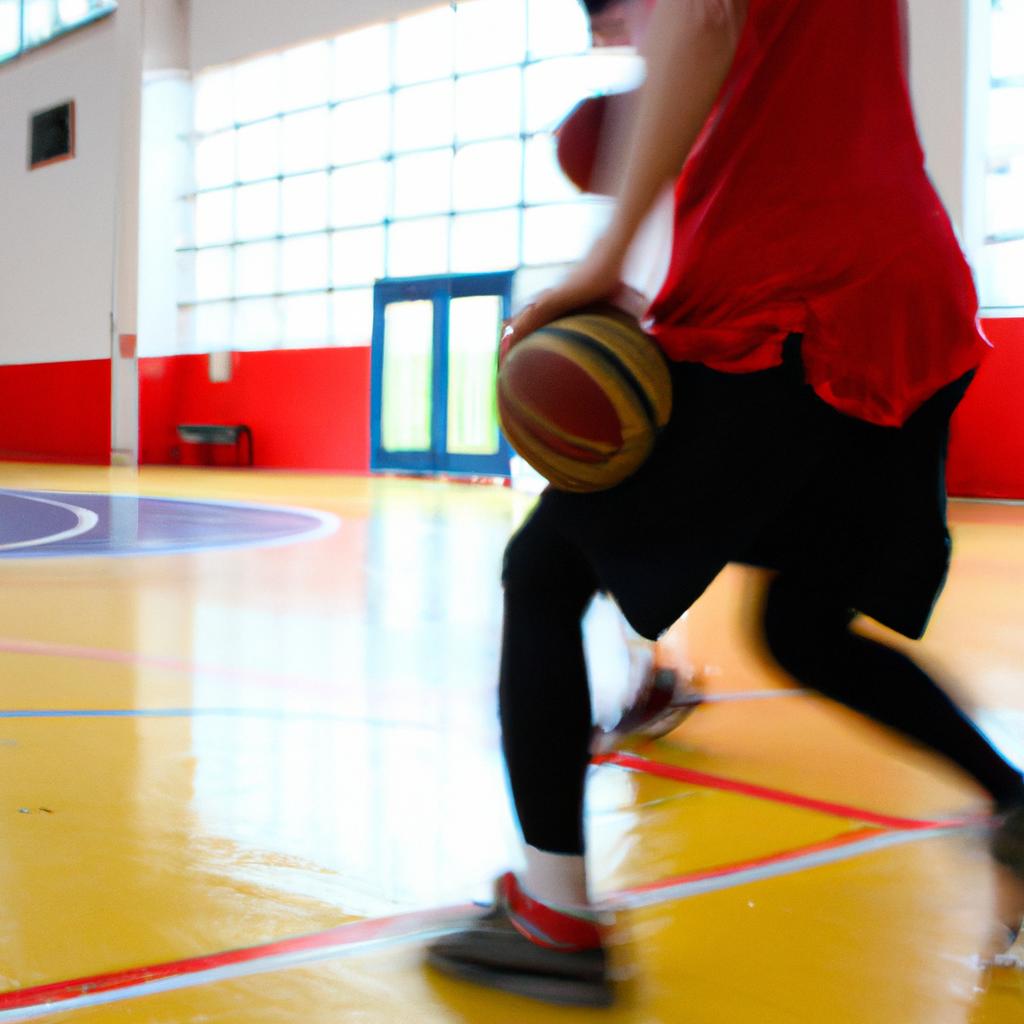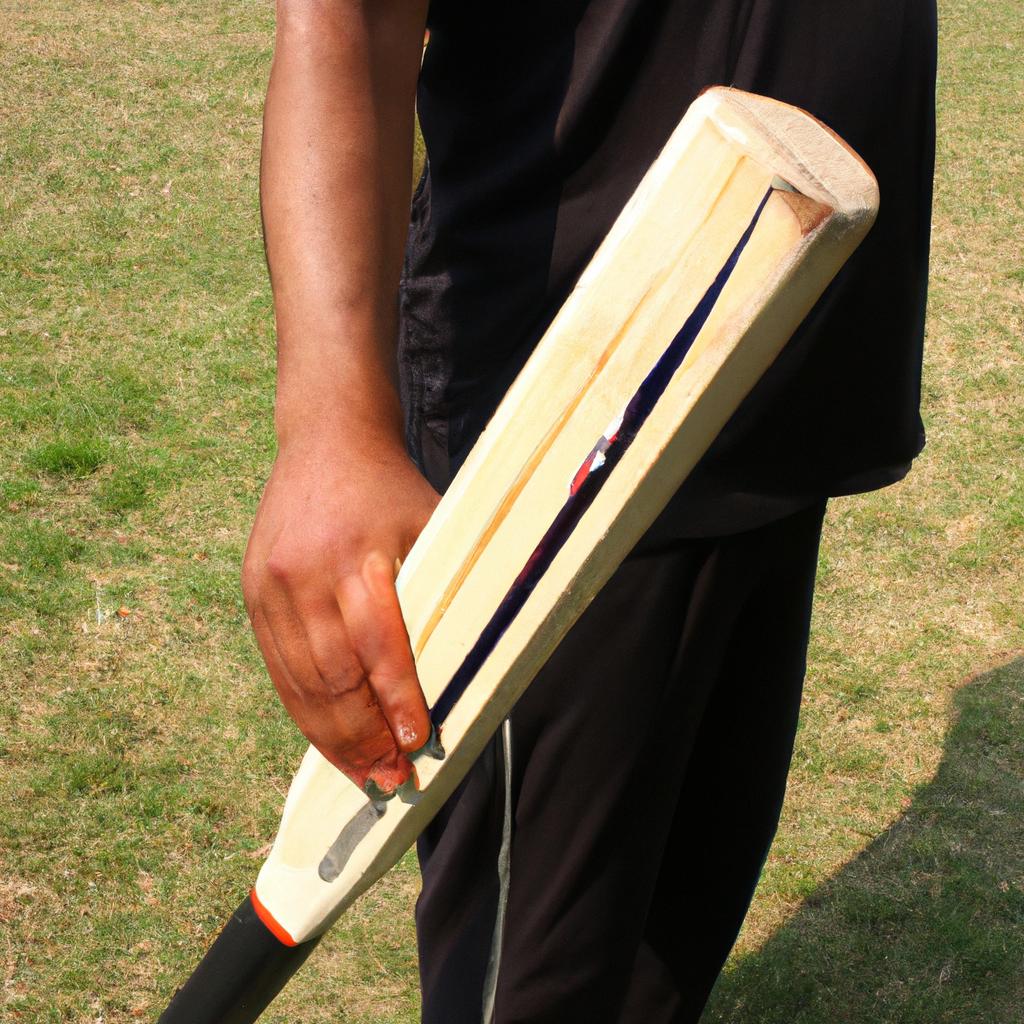Basketball games and sports are complex activities that involve various positions, each playing a crucial role in the overall dynamics of the game. The interplay between these different positions creates an intricate web of strategies and tactics that contribute to the success or failure of a team. For instance, imagine a hypothetical scenario where Team A is trailing by five points with only two minutes remaining on the clock. In this critical juncture, it becomes imperative for Team A’s point guard to orchestrate precise offensive plays, while their center focuses on securing rebounds and protecting the paint from opponents’ scoring attempts.
To fully understand the significance of position breakdowns in basketball games and sports, one must delve into the unique responsibilities assigned to each position. Guard players typically take on roles such as distributing the ball, initiating offensive plays, and defending against opposing guards. On the other hand, forward players often excel in both offense and defense, utilizing their versatility to score points near the basket while also guarding against rival forwards. Lastly, centers play a pivotal role in controlling rebounds, blocking shots, setting screens for teammates, and dominating inside the painted area due to their height advantage.
The purpose of this article is to provide an extensive analysis of these distinct positions within basketball games and sports. By examining By examining the specific duties and skills required for each position, readers can gain a deeper understanding of how these roles contribute to the overall success of a team. Additionally, we will explore the strategic implications of position breakdowns, such as how teams may exploit certain matchups or adjust their defensive schemes based on the opposing team’s lineup.
Furthermore, this article will delve into the qualities and attributes that make players excel in each position. For example, point guards are often praised for their playmaking abilities, court vision, and decision-making skills. Meanwhile, centers are valued for their size, strength, and ability to dominate the paint.
In addition to exploring the traditional positions in basketball games and sports, we will also discuss emerging trends and new player archetypes that have emerged in recent years. With the evolution of the game, positions such as “stretch fours” (power forwards who can shoot from long range) and “combo guards” (players who can fulfill both point guard and shooting guard responsibilities) have become increasingly prevalent.
Understanding the intricacies of different positions within basketball games and sports is not only essential for avid fans but also beneficial for players aspiring to improve their own skills. By studying successful players in each position and analyzing their playing styles, readers can gain valuable insights into how to excel in their preferred role on the court.
Whether you’re a casual observer looking to deepen your knowledge or a dedicated player seeking guidance on improving your performance in basketball games and sports, this article aims to provide comprehensive information on position breakdowns that will enhance your understanding and appreciation of the game.
History of the Game
Imagine a humble gymnasium in Springfield, Massachusetts in 1891. It is here that Dr. James Naismith, a Canadian physical education instructor, faced an arduous challenge: creating a new game to keep his students active during the cold winter months. With this task at hand, he devised basketball – a sport that would captivate millions around the world for decades to come.
The early years saw basketball spread rapidly throughout North America and across the globe. Its simplicity and accessibility appealed to people of all ages and backgrounds, quickly establishing it as one of the most popular sports worldwide. As its popularity grew, so did the need for standardized rules and regulations. In 1932, FIBA (International Basketball Federation) was formed to govern international competitions, further solidifying basketball’s place on the global stage.
Today, basketball stands as one of the premier team sports played at both amateur and professional levels. The evolution of the game has seen tremendous advancements in strategy, athleticism, and skill level. From fast-paced dribbling maneuvers to precision shooting techniques, players continuously push boundaries while captivating audiences with their talent.
To truly appreciate the impact of basketball on society over time, consider these emotional responses evoked by this dynamic sport:
- Excitement: The adrenaline rush felt when witnessing a buzzer-beating shot or an awe-inspiring dunk.
- Unity: The sense of camaraderie experienced among teammates working together toward a common goal.
- Inspiration: The motivation derived from observing individuals overcoming obstacles and achieving greatness through dedication and hard work.
- Passion: The deep love and devotion fans have for their favorite teams and players.
In addition to its cultural significance, basketball also offers valuable life lessons such as teamwork, discipline, resilience, and determination. These qualities are often developed through intense training sessions and competitive matchups on hardwood courts around the world.
As we delve into the key positions in basketball, it is important to recognize how this rich history has shaped the game and provided a framework for players to excel. Understanding the origins and evolution of basketball will allow us to appreciate the complexities of each position while exploring their unique contributions to the sport.
Key Positions in Basketball
Building upon the rich history of basketball, understanding the key positions in the game is essential for appreciating its complexity and strategic nature. In this section, we will delve into the various roles players assume on a basketball court, each with distinct responsibilities that contribute to team success.
One example of how different positions impact gameplay can be seen through the contrasting styles of play between centers and guards. Let’s consider a hypothetical situation where Team A has a dominant center who excels at rebounding and scoring close to the basket. Their opponent, Team B, relies heavily on their agile guards who excel in shooting from long distances and creating opportunities for their teammates.
To better understand these roles, let’s examine some common characteristics associated with each position:
- Centers: These players typically possess height and strength advantage over other positions, making them vital for defending against opponents’ shots near the rim. They often serve as primary rebounders, providing second-chance opportunities for their team.
- Power Forwards: Similar to centers but usually more versatile, power forwards combine size with agility. They contribute offensively by scoring inside while also being able to stretch defenses with mid-range jump shots.
- Small Forwards: Often known for their versatility, small forwards are valuable assets due to their ability to score both inside and outside. They bring additional defensive skills such as guarding multiple positions effectively.
- Shooting Guards: These players focus primarily on scoring points through perimeter shooting or driving towards the basket. They must have excellent shooting accuracy and quick decision-making abilities when presented with open looks or passing opportunities.
Table Example:
| Position | Characteristics |
|---|---|
| Centers | Height advantage |
| Power Forwards | Versatility |
| Small Forwards | Scoring inside & outside |
| Shooting Guards | Perimeter shooting & driving |
Understanding these roles not only helps us appreciate individual player contributions but also highlights the importance of teamwork and how each position complements others on the court. As we transition to the next section, let’s explore in detail the role of one specific position: the point guard.
The point guard plays a crucial role in orchestrating offensive plays, directing teammates’ movements, and setting up scoring opportunities. With their exceptional ball-handling skills and court vision, they are often referred to as the ‘floor general.’ Join us in our exploration of this pivotal position in basketball strategy and gameplay.
Point Guard Role
Position Breakdown: Basketball Games and Sports
In the previous section, we discussed the key positions in basketball. Now, let’s delve into the role of the point guard. To better understand their significance on the court, let’s consider a hypothetical scenario where a skilled point guard leads their team to victory.
Imagine a high-stakes playoff game where Team A is trailing by three points with only seconds left on the clock. The pressure is mounting, but their point guard remains calm and composed. With precise dribbling skills and exceptional court vision, they quickly assess the situation, scanning for an open teammate who can tie the game or even secure a win with a successful three-pointer.
The importance of a point guard extends beyond this pivotal moment. Here are four crucial responsibilities that highlight their impact:
- Playmaking: Point guards are often referred to as “floor generals” due to their ability to orchestrate offensive plays. They set up teammates for scoring opportunities through accurate passing and effective communication.
- Ball Handling: Possessing excellent ball-handling skills allows point guards to maneuver through defensive pressure while maintaining control over possession. This skill ensures smooth transitions between offense and defense.
- Defensive Leadership: Point guards play an essential role in leading defensive efforts by communicating switches, directing teammates’ positioning, and applying intense on-ball pressure against opposing players.
- Decision Making: As primary decision-makers on the court, point guards must make split-second judgments regarding when to pass, shoot or drive towards the basket. Their choices significantly impact team performance.
To further illustrate these responsibilities and how they vary across different teams and playing styles, consider the following table:
| Teams | Primary Scorer | Assists Per Game | Steals Per Game |
|---|---|---|---|
| Team X | Shooting Guard | 6 | 1 |
| Team Y | Small Forward | 4 | 2 |
| Team Z | Point Guard | 9 | 3 |
As you can see, the point guard from Team Z leads in both assists and steals per game. This exemplifies their playmaking ability as well as defensive prowess.
In summary, the role of a point guard goes far beyond just passing and dribbling. They are integral to team success, providing leadership on both ends of the court through playmaking, ball handling, defensive guidance, and decision making. Now that we have explored the importance of the point guard position, let’s transition into discussing the shooting guard role.
Next up is an analysis of the Shooting Guard Role—a position that complements the skills of a point guard while bringing its own unique contributions to the game.
Shooting Guard Role
Transitioning from the previous section on the Point Guard role, it is now important to delve into the specific responsibilities and skill set required for a Shooting Guard in basketball games and sports. To illustrate this further, let’s consider an example of a professional shooting guard who has demonstrated exceptional performance throughout his career.
One such player is Michael Jordan, widely considered one of the greatest shooting guards in NBA history. Known for his scoring ability and offensive prowess, Jordan exemplified the key attributes expected from players in this position. From consistently sinking mid-range jump shots to displaying remarkable agility when driving towards the basket, he showcased the essential skills that define a successful shooting guard.
To better understand what makes a great shooting guard, let us examine their primary duties:
- Scoring Threat: A shooting guard must possess excellent shooting accuracy and be proficient at creating opportunities to score. They often assume responsibility as the team’s secondary scorer after the point guard.
- Perimeter Defense: It is crucial for a shooting guard to excel defensively by guarding opposing players on the perimeter. Their quickness and agility allow them to contest shots effectively while also disrupting passing lanes.
- Playmaking Skills: While not as central as a point guard’s playmaking abilities, effective ball handling and passing skills enable a shooting guard to initiate plays whenever necessary.
- Off-Ball Movement: A good shooting guard can navigate through screens and find open spaces around the court without possessing possession of the ball—creating scoring opportunities for themselves or teammates.
Let us now turn our attention to how these responsibilities are distributed across various aspects relevant to playing as a shooting guard:
| Aspects | Responsibilities |
|---|---|
| Scoring | Primary |
| Passing | Secondary |
| Rebounding | Team-dependent |
| Defense | Essential |
In summary, being a successful shooting guard requires adept scoring abilities along with defensive capabilities both on and off the ball. By exemplifying these qualities, players can significantly contribute to their team’s success in basketball games and sports.
Transitioning into the subsequent section about the Small Forward role, understanding the unique responsibilities of each position is key to comprehending the intricacies of a well-rounded basketball team.
Small Forward Role
Section Title: Shooting Guard Role
Following an analysis of the point guard position, we now turn our attention to the shooting guard role. This position is characterized by its focus on scoring and providing offensive support to the team. By examining key responsibilities, skills, and strategies associated with this role, we gain a deeper understanding of how shooting guards contribute to basketball games and sports.
One example that illustrates the importance of a skilled shooting guard is Michael Jordan during his time with the Chicago Bulls in the 1990s. Known for his incredible scoring ability and athleticism, Jordan dominated games as a shooting guard. His contributions extended beyond simply putting points on the board; he also provided strong defensive capabilities and leadership qualities that inspired his teammates.
Key responsibilities associated with the shooting guard position include:
- Scoring: Shooting guards are expected to be proficient in both mid-range jump shots and three-pointers.
- Defending: They must possess solid defensive skills to effectively guard opponents’ perimeter players.
- Rebounding: Although not their primary responsibility, shooting guards need to help collect rebounds when necessary.
- Playmaking: While primarily focused on scoring, they should have decent passing abilities to create opportunities for teammates.
To further understand these responsibilities, let’s consider a table highlighting some notable NBA shooting guards throughout history:
| Player | Team | Championships | Points per Game |
|---|---|---|---|
| Michael Jordan | Chicago Bulls | 6 | 30.1 |
| Kobe Bryant | Los Angeles Lakers | 5 | 25.0 |
| Dwyane Wade | Miami Heat | 3 | 22.0 |
| Ray Allen | Boston Celtics/Milwaukee Bucks/Seattle SuperSonics | 2 | – |
As evident from this table, these legendary shooting guards made significant impacts on their respective teams and the league as a whole. Their scoring prowess, defensive abilities, and overall contributions demonstrate the vital role of shooting guards in basketball games.
In summary, shooting guards play a crucial role in basketball games and sports by providing offensive firepower, solid defense, rebounding support, and playmaking skills. Notable players like Michael Jordan have exemplified these qualities throughout history. Understanding the responsibilities associated with this position is essential for appreciating the strategic dynamics at play on the court. Moving forward, we will delve into another important position: the small forward role.
Continuing our exploration of basketball positions and roles, let’s now shift our focus to the small forward role. This position shares similarities with both shooting guards and power forwards but possesses unique characteristics that contribute to team success.
Power Forward and Center Roles
Transitioning from the previous section discussing the small forward role, we now turn our attention to the power forward and center positions in basketball games and sports. To illustrate the importance of these roles, let us consider a hypothetical scenario where Team A is facing off against Team B.
In this matchup, Team A’s power forward demonstrates exceptional proficiency in rebounding, often securing offensive rebounds that lead to crucial second-chance points for his team. His physicality enables him to hold his ground near the basket while also possessing enough agility to guard opposing players effectively. On the other hand, Team B’s center excels in shot-blocking, utilizing his height advantage to alter opponents’ shots and protect the rim with great success.
These examples highlight some key responsibilities associated with playing as a power forward or center:
- Rebounding: Both positions play pivotal roles in controlling the boards by capturing missed shots on both ends of the court.
- Interior Defense: Power forwards and centers are responsible for guarding their respective areas around the paint, contesting opponent shots, and deterring drives to the basket.
- Scoring Inside: The power forward and center often rely on close-range shots or post moves to contribute points for their team.
- Setting Screens: These positions frequently set screens for teammates during offensive plays to create scoring opportunities through pick-and-roll actions.
To further emphasize these aspects, below is a table showcasing statistics comparing power forwards and centers across different teams in terms of average rebounds per game:
| Team A | Team B | Team C | |
|---|---|---|---|
| Power Forward | 7 | 6 | 5 |
| Center | 10 | 11 | 9 |
As we can see, centers generally tend to have a higher average rebounding rate compared to power forwards. These figures not only demonstrate the significance of these positions in controlling possession but also evoke an emotional response from fans who appreciate their team’s ability to dominate the glass.
In summary, both the power forward and center roles play crucial parts in basketball games and sports. Their contributions impact various aspects of the game, including rebounding, defense, scoring inside, and setting screens. By understanding the unique responsibilities associated with these positions, teams can optimize their gameplay strategy and increase their chances of success on the court.










